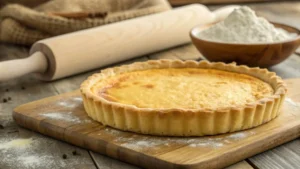Introduction
 Quiche is a timeless dish, celebrated for its creamy filling and flaky crust, but many home cooks struggle with one common issue: how to make a quiche without a soggy bottom. This problem often arises from improper techniques or overly moist ingredients. Understanding how to make a quiche without a soggy bottom involves mastering methods like blind baking, using an egg wash, and layering ingredients strategically to prevent moisture seepage.
Quiche is a timeless dish, celebrated for its creamy filling and flaky crust, but many home cooks struggle with one common issue: how to make a quiche without a soggy bottom. This problem often arises from improper techniques or overly moist ingredients. Understanding how to make a quiche without a soggy bottom involves mastering methods like blind baking, using an egg wash, and layering ingredients strategically to prevent moisture seepage.
If you’ve ever wondered how to make a quiche without a soggy bottom, you’re not alone! Perfecting this dish is about paying attention to details such as filling preparation, proper baking temperatures, and choosing the right pastry. By following the steps outlined in this guide, you’ll learn how to make a quiche without a soggy bottom and elevate your quiche-making skills. A crisp crust is within your reach with these tried-and-true tips!
By repeating the focus keyphrase naturally throughout your content, you not only improve its SEO but also ensure readers immediately understand your topic and find value in your guide.
Understanding the Causes of a Soggy Bottom
A soggy bottom crust is one of the most common disappointments when baking a quiche, and understanding its causes is the first step to preventing it. The primary culprit is excess moisture, which can seep from fillings like vegetables, meats, or even the custard itself during baking. Ingredients like mushrooms, tomatoes, or spinach contain high water content and, if not pre-cooked or drained properly, can release moisture that soaks into the crust.
Another key factor is improper baking techniques. Skipping essential steps like blind baking—pre-baking the crust before adding the filling—leaves the pastry undercooked and vulnerable to moisture absorption. Additionally, an incorrectly set oven temperature can prevent the crust from fully cooking, further contributing to a soggy texture.
By addressing these factors—reducing moisture in fillings and ensuring proper baking methods—you can eliminate the common pitfalls that lead to a soggy quiche crust and achieve a crisp, golden result every time.
Choosing the Right Pastry for Your Quiche
The foundation of a perfect quiche lies in its crust, and selecting the right pastry is crucial for achieving the desired texture and flavor. Two popular options are shortcrust pastry and puff pastry, each with unique characteristics.
Shortcrust pastry, the classic choice for quiche, offers a firm yet tender base. Its dense structure supports the filling well and creates a sturdy, buttery crust that doesn’t overpower the quiche’s flavors. It’s ideal for maintaining a crisp texture, especially when blind-baked properly.
Puff pastry, on the other hand, is lighter and flakier, with its numerous layers adding an airy crunch to each bite. While puff pastry can lend an elegant touch to the dish, it’s more prone to sogginess if not handled with care. Additionally, its delicate texture may not provide the same support as shortcrust for heavier fillings.
When deciding between homemade and store-bought pastry, consider convenience and control. Homemade pastry allows for customization, better quality control, and a fresher taste, but it requires time and skill. Store-bought options are a time-saver and work well when pre-baked and paired with thoughtful preparation.
Ultimately, the best choice depends on your preferences, with shortcrust being the go-to for a traditional, crisp quiche crust.
The Importance of Blind Baking
One of the key techniques in how to make a quiche without a soggy bottom is blind baking. This process involves pre-baking the crust before adding the filling, ensuring it stays crisp even with the addition of moist custards and ingredients. Blind baking is an essential step when learning how to make a quiche without a soggy bottom, as it helps set the crust and prevents it from absorbing excess moisture.
To blind bake, start by rolling out your pastry dough and fitting it into the quiche pan. Next, chill the crust to maintain its shape during baking. Then, line the crust with parchment paper or foil and fill it with pie weights or an alternative like dried beans. Baking the crust at 375°F (190°C) for about 15 minutes allows it to firm up. Removing the weights and baking for another 5-10 minutes ensures the base is fully set.
When mastering how to make a quiche without a soggy bottom, blind baking plays a pivotal role. It’s the foundation of a crisp, golden crust that can hold up against a rich filling. This step ensures your quiche not only looks beautiful but tastes as perfect as it should.
Step-by-Step Guide to Blind Baking a Quiche Crust

- Prepare the Dough: Roll out your pastry dough to fit your pie or tart pan. Gently press it into the pan, ensuring it fits snugly into the corners and sides. Trim any excess dough for a clean edge.
- Chill the Crust: Refrigerate the crust for at least 30 minutes. This step prevents shrinkage during baking.
- Dock the Dough: Use a fork to prick small holes in the base of the crust. This prevents air pockets from forming during baking.
- Add Weights: Line the crust with parchment paper or aluminum foil, then fill it with pie weights, dried beans, or rice. These weights keep the crust flat and prevent puffing.
- Pre-Bake the Crust: Place the pan in a preheated oven (about 375°F/190°C) and bake for 15-20 minutes, or until the edges are lightly golden.
- Remove Weights and Bake Again: Carefully remove the weights and lining, then return the crust to the oven for 5-10 minutes until the base is dry and slightly golden.
Blind baking is the cornerstone of a quiche with a crisp, delicious crust. With this method, you’re set up for success every time.
Using Pie Weights or Alternatives
Pie weights are essential tools for blind baking, as they help maintain the crust’s shape and prevent it from puffing or shrinking during baking. Without weights, the pastry can bubble up, lose its even base, or collapse from the sides, making it difficult to fill and bake evenly. Pie weights exert gentle pressure, ensuring the crust stays flat and uniform while it sets in the oven.
If you don’t have pie weights on hand, several household items work just as well. Dried beans and uncooked rice are the most common alternatives. They are heavy enough to keep the crust in place and can be reused multiple times for blind baking. Simply store them in a jar labeled “baking only” to avoid accidental cooking use.
Other options include lentils, sugar, or even pennies (lined with parchment paper). Each offers an easy and cost-effective way to ensure your crust is perfectly baked, no weights required.
Applying an Egg Wash to Seal the Crust
An egg wash is a simple yet effective method to create a moisture barrier for your quiche crust. By brushing the crust with a beaten egg or egg yolk, you form a protective layer that prevents the custard and fillings from soaking into the pastry. This step ensures the crust remains crisp and golden after baking, even with a moist filling.
How to Apply an Egg Wash
- Prepare the Egg Wash: Beat one egg or egg yolk with a tablespoon of water or milk until smooth. This combination provides a glossy finish and creates an effective seal.
- Apply After Blind Baking: Once the crust has been partially blind-baked and cooled slightly, brush a thin, even layer of the egg wash over the entire surface, focusing on the base and sides.
- Bake Again: Return the crust to the oven for 2-3 minutes to set the egg wash. This quick bake ensures the coating hardens, forming a waterproof layer.
An egg wash is a simple step that makes a big difference, preserving the integrity of your crust while adding a touch of professional polish.
Selecting and Preparing Fillings
 Choosing the right fillings for your quiche is essential, but preparing them correctly is just as critical to avoid a soggy bottom crust. One of the biggest culprits of a waterlogged quiche is excess moisture from the ingredients. Vegetables, meats, and even cheeses can release liquids during baking, compromising the crust’s crispness. Reducing moisture in fillings is a vital step for success.
Choosing the right fillings for your quiche is essential, but preparing them correctly is just as critical to avoid a soggy bottom crust. One of the biggest culprits of a waterlogged quiche is excess moisture from the ingredients. Vegetables, meats, and even cheeses can release liquids during baking, compromising the crust’s crispness. Reducing moisture in fillings is a vital step for success.
Pre-Cooking Vegetables
Many vegetables, such as spinach, mushrooms, zucchini, and tomatoes, have high water content. Pre-cooking these ingredients helps evaporate excess moisture, concentrating their flavors while making them less likely to release water during baking. For instance:
- Spinach: Sauté in a pan and squeeze out the liquid with a clean towel or cheesecloth.
- Mushrooms: Cook on medium heat until their juices are released and reabsorbed.
- Zucchini: Sprinkle with salt, let it sit for 10 minutes, then pat dry to remove moisture.
Draining Meats and Other Ingredients
Cooked meats like bacon, sausage, or ground beef should be drained on paper towels to remove excess grease. Similarly, cheeses, especially fresh varieties like ricotta or mozzarella, may require patting dry to reduce moisture.
Layering to Protect the Crust
Place drier ingredients, like shredded cheese or breadcrumbs, as a base layer over the crust. These act as a buffer, absorbing residual moisture from wetter ingredients above.
Proper preparation of fillings not only ensures a crisp crust but also enhances the overall flavor and texture of your quiche.
Proper Egg and Dairy Ratios for the Custard
The foundation of a quiche’s creamy filling is its custard, a delicate balance of eggs and dairy. Achieving the right ratio is essential for a firm yet velvety texture that holds together without being too runny or rubbery.
Ideal Egg-to-Dairy Ratios
A commonly recommended ratio is 1 egg for every ½ cup (120 ml) of dairy. For a standard 9-inch quiche, which typically requires 1 ½ cups of liquid, you’ll need 3 large eggs. This proportion ensures the custard sets properly while maintaining a smooth consistency. Adjustments can be made based on personal preference, but straying too far may affect the final texture.
Impact of Different Dairy Products
The type of dairy you use significantly influences the custard’s richness and mouthfeel. For a traditional quiche, heavy cream or half-and-half provides a luxurious, creamy texture due to its higher fat content. Mixing heavy cream with whole milk creates a balanced custard that is rich without being overly heavy.
For lighter alternatives, low-fat milk can be used, but keep in mind that the custard may be less creamy and more prone to cracking. Non-dairy options like almond or oat milk can work but may require thickening agents for a firmer set.
The right egg-to-dairy ratio, paired with your choice of dairy, ensures a custard that is perfectly creamy and stable, providing a flawless base for your quiche.
Layering Ingredients to Protect the Crust
A simple but effective way to keep your quiche crust crisp is to layer protective ingredients on the base before adding the filling. This technique creates a barrier that prevents moisture from the custard or fillings from seeping into the crust.
Cheese as a Protective Layer
Sprinkling a layer of shredded cheese, such as Gruyère, cheddar, or Parmesan, directly onto the blind-baked crust is an excellent method. As the quiche bakes, the cheese melts and forms a thin, flavorful seal that locks out moisture. Hard cheeses are particularly effective due to their low water content.
Breadcrumbs for Extra Absorption
Alternatively, a light sprinkling of breadcrumbs can absorb excess moisture from wet ingredients, providing additional protection. Use fine, dry breadcrumbs for the best results. For added flavor, you can mix breadcrumbs with grated Parmesan or herbs.
By incorporating a layer of cheese or breadcrumbs, you enhance both the texture and taste of your quiche while ensuring the crust remains beautifully crisp and intact.
Optimal Baking Temperatures and Times
Baking your quiche at the right temperature and for the correct duration is essential for achieving a perfectly cooked filling and a crisp crust. The ideal oven temperature for quiche is 375°F (190°C). This moderate heat ensures the custard sets gently without overcooking or curdling while allowing the crust to bake evenly.
Recommended Baking Duration
Most 9-inch quiches bake in 35 to 45 minutes at this temperature. To ensure even cooking, start checking for doneness at the 30-minute mark. The filling should be just set with a slight wobble in the center; it will firm up as it cools. Overbaking can cause the custard to become rubbery and may lead to cracks.
Importance of Oven Placement
Position the quiche on the middle rack of the oven. This placement ensures even heat distribution, allowing both the crust and filling to cook properly. Using a baking sheet under the quiche pan can provide additional stability and catch any spills, while also promoting even heat on the bottom crust.
Avoid placing the quiche too close to the top or bottom of the oven, as this can lead to uneven baking or scorching. Proper temperature and placement are key to a beautifully cooked quiche with a golden crust and creamy filling.
Cooling and Serving the Quiche
Allowing your quiche to cool and set before slicing is a crucial step that ensures the best texture and presentation. When the quiche first comes out of the oven, the custard is still soft and may appear slightly wobbly in the center. During cooling, the residual heat continues to cook the custard gently, allowing it to firm up to the perfect consistency.
Slicing the quiche too early can cause the filling to spill out and the crust to crumble, resulting in a less appealing dish. For optimal results, let the quiche rest at room temperature for at least 15 to 20 minutes after baking. This brief resting period makes it easier to slice cleanly and serve.
Quiche can be enjoyed warm, at room temperature, or even cold, depending on preference. However, proper cooling ensures that each slice holds its shape, showcasing the beautiful layers of crust, filling, and custard.
Storing Leftovers Without Compromising the Crust
Proper storage and reheating are essential to maintaining the quality of a leftover quiche, especially the crispness of its crust. To refrigerate, allow the quiche to cool completely to room temperature. Then, wrap it tightly in plastic wrap or aluminum foil, or store it in an airtight container. This prevents moisture from accumulating, which could make the crust soggy. Quiche can be safely refrigerated for up to 3 to 4 days.
When reheating, avoid using the microwave, as it can turn the crust soft and chewy. Instead, use an oven or toaster oven for the best results. Preheat the oven to 325°F (165°C), place the quiche on a baking sheet, and cover it loosely with aluminum foil to prevent over-browning. Heat for 15 to 20 minutes, or until warmed through.
Looking for More Quiche Inspiration?
For more ideas on creating delicious quiches, or to explore ready-made options for inspiration, check out Costco Mini Quiche. This resource provides an overview of mini quiches that can spark creativity for your own homemade versions, ensuring you achieve perfect results every time.
Frequently Asked Questions (FAQs)
1. How do you keep the bottom of a quiche crust from getting soggy?
To prevent a soggy bottom, blind bake the crust before adding the filling. This involves pre-baking the pastry partially or fully without the filling, which sets the crust and creates a barrier against moisture. Adding a layer of cheese or breadcrumbs before the filling also helps absorb excess liquid and protect the crust.
2. Should you prebake crust for quiche?
Yes, prebaking, or blind baking, the crust is highly recommended. It ensures the crust is firm and golden before the wet filling is added, significantly reducing the risk of a soggy bottom. Be sure to use pie weights to keep the crust flat during this step.
3. How do I make my bottom pie crust crispy?
For a crispy bottom crust, start with a cold, well-chilled dough, and avoid over-handling it. Blind bake the crust at the right temperature, and consider brushing it with an egg wash to create a moisture-resistant seal. Placing the quiche on a preheated baking sheet also helps crisp the bottom by evenly distributing heat.
4. How do you crisp the bottom of a quiche?
To crisp the bottom of a quiche, preheat a baking sheet and place the quiche pan directly on it. This transfers heat efficiently to the crust, ensuring it bakes evenly and crisps up nicely. Avoid overloading the filling with moisture-rich ingredients to keep the base dry.
By following these steps, you can enjoy your quiche leftovers with the same delightful texture and flavor as when freshly baked.
Conclusion
Making a quiche with a perfectly crisp crust is an achievable goal with the right techniques and attention to detail. By understanding the causes of a soggy bottom, blind baking the crust, using an egg wash, and carefully selecting and preparing fillings, you can ensure a beautifully golden and flaky base. Balancing the custard with the ideal egg-to-dairy ratio and baking at the correct temperature further enhances the dish. With these expert tips, your quiche will not only look impressive but also taste delightful, making it a standout addition to any meal. Perfect your quiche, one crust at a time!

1 thought on “How do you make a quiche without a soggy bottom?”